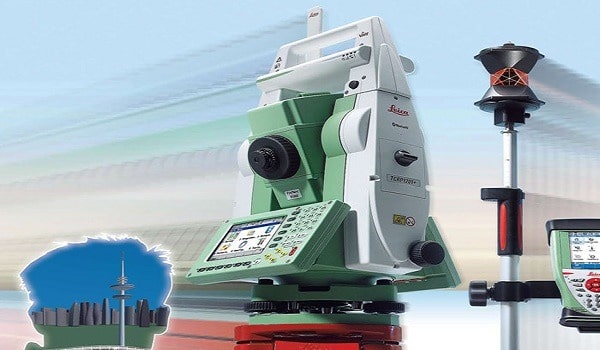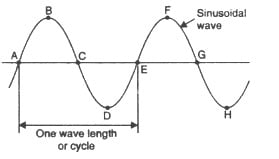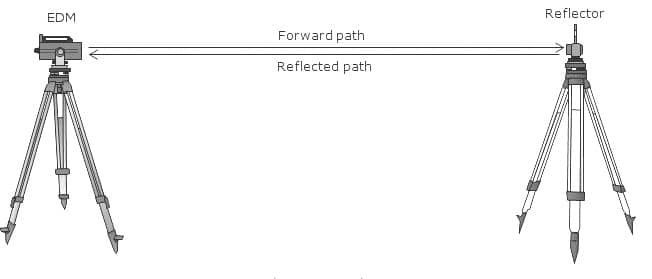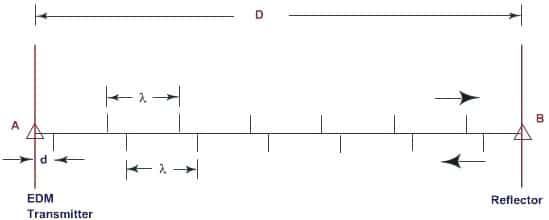Electronic Distance Measurement Instrument- Types, Functions & Operations
Electronic Distance Measurement Instrument- Types, Functions & Operations:
Electronic distance measuring instrument is a surveying instrument for measuring distance electronically between two points through electromagnetic waves.
Electronic distance measurement (EDM) is a method of determining the length between two points, using phase changes, that occur as electromagnetic energy waves travels from one end of the line to the other end. As a background, there are three methods of measuring distance between two points:
DDM or Direct distance measurement – This is mainly done by chaining or taping.
ODM or Optical distance measurement – This measurement is conducted by tacheometry, horizontal subtense method or telemetric method. These are carried out with the help of optical wedge attachments.
EDM or Electromagnetic distance measurement – The method of direct distance measurement cannot be implemented in difficult terrains. When large amount of inconsistency in the terrain or large obstructions exist, this method is avoided.
As an alternative to this optical distance measurement method was developed. Still it gained a disadvantage of limited range of measurement. It is limited to 15 to 150m with an accuracy of 1 in 1000 to 1 in 10000. Above all we have EDM with an accuracy of 1 in 105, having a distance range of 100km.
Electronic distance measurement in general is a term used as a method for distance measurement by electronic means. In this method instruments are used to measure distance that rely on propagation, reflection and reception of electromagnetic waves like radio, visible light or infrared waves.
Sun light or artificially generated electromagnetic wave consists of waves of different lengths. The spectrum of an electromagnetic wave is as shown below:

Among these waves microwaves, infrared waves and visible light waves are useful for the distance measurement. In EDM instruments these waves are generated, modulated and then propagated. They are reflected at the point up to which distance is to be measured from the instrument station and again received by the instrument.
The time taken by the wave to travel this 2x distance may be measured and knowing the velocity of wave, the distance may be calculated. However time is too short, measuring the time taken is difficult.
The improved techniques use phase difference method in which the number of completed wave and incomplete wave is measured. Knowing the length of wave, distances are calculated.

Built up microprocessors provided in the instrument calculate the distances and display it by liquid crystal display (LCD).
Origin of Electronic Distance Measurement
Electronic distance measurement can be done by instruments like geodimeter, tellurometer or distomat etc. The first EDM instrument called geodimeter was developed in Sweden in the year 1948. Geodimeter is geodetic distance meter developed based on a modulated light beam.
The second instrument for EDM was designed and developed in Africa in the year 1957, named tellurometer. This instrument employs modulated microwaves.
As years passed technology has improved drastically. At present, we have modern EDMs that displays distance in digital form and many gains microcomputers that calculates horizontal and vertical distance i.e. DX and DY. They also show sloped distance (DH).
Electronic distance measurement equipments are incorporated along with theodolites that possess automatic angle readout called as total station (electronic tacheometers) also called as field to finish systems. These record distance and angles simultaneously.
Types of Electronic Distance Measurement Instrument
EDM instruments are classified based on the type of carrier wave as
- Microwave instruments
- Infrared wave instruments
- Light wave instruments.
1. Microwave Instruments
These instruments make use of microwaves. Such instruments were invented as early as 1950 in South Africa by Dr. T.L. Wadley and named them as Tellurometers. The instrument needs only 12 to 24 V batteries. Hence they are light and highly portable. Tellurometers can be used in day as well as in night.
The range of these instruments is up to 100 km. It consists of two identical units. One unit is used as master unit and the other as remote unit. Just by pressing a button, a master unit can be converted into a remote unit and a remote unit into a master unit. It needs two skilled persons to operate. A speech facility is provided to each operator to interact during measurements.
2. Infrared Wave Instruments
In this instrument amplitude modulated infrared waves are used. Prism reflectors are used at the end of line to be measured. These instruments are light and economical and can be mounted on theodolite. With these instruments accuracy achieved is ± 10 mm. The range of these instruments is up to 3 km.
These instruments are useful for most of the civil engineering works. These instruments are available in the trade names DISTOMAT DI 1000 and DISTOMAT DI 55.
3. Visible Light Wave Instruments
These instruments rely on propagation of modulated light waves. This type of instrument was first developed in Sweden and was named as Geodimeter. During night its range is up to 2.5 km while in day its range is up to 3 km. Accuracy of these instruments varies from 0.5 mm to 5 mm/km distance. These instruments are also very useful for civil engineering projects.
Operations of Electronic Distance Measurement Instruments
It is essential to know the fundamental principle behind EDM to work with it. The electromagnetic waves propagate through the atmosphere based on the equation

Where ‘v’ is the velocity of electromagnetic energy in meters per second(m/sec); f is the modulated frequency in hertz (Hz) and  is, the wavelength measured in meters. Mainly the waves that are propagated can be represented like a sine wave as shown in figure below.
is, the wavelength measured in meters. Mainly the waves that are propagated can be represented like a sine wave as shown in figure below.
Another property of wave called as phase of wave  , is a very convenient method of small fraction of wavelength during measurement in EDM. The points A, B, C etc. represents various phase points
, is a very convenient method of small fraction of wavelength during measurement in EDM. The points A, B, C etc. represents various phase points

Fig. Sinusoidal Waves

Fig. Corresponding phase values
Say AB is the survey line to me measured, having a length of D. The EDM equipment is placed at ends A and B. A transmitter is placed at A and a receiver is placed at B. the transmitter lets propagation of electromagnetic waves towards B. A timer is also placed. At the instant of transmission of wave from A the timer at B starts and stops at the instant of reception of incoming wave at B. This enable us to know the transit time for the wave from the point A to B.

Fig. Transit Time Measurement Demonstration
From the transit time and known velocity, the distance can be easily measured. Now to solve the problem arise due to difficulty in starting the timer at B, a reflector can be placed as shown below instead of a receiver at B.

Fig. Transit measurement arrangement with the help of a EDM and a reflector
Measurement of distance with EDM and a Reflector
As explained let the waves get transmitted from A and reflected from B. If the received signal is out of phase by a measure of  , then equivalent distance is
, then equivalent distance is
Thus, the distance

where n is the integral number of wavelength,  in the double path
in the double path

Error in Electronic Distance Measurement Instruments
Personal Errors
- Inaccuracy in initial setups of EDMs and the reflectors over the preferred stations
- Instrument and reflector measurements going wrong
- Atmospheric pressures and temperature determination errors
Instrumental Errors
- Calibration errors
- Chances of getting maladjusted time to time generating frequent errors
- Errors shown by the reflectors
Natural Errors
- Atmospheric variations in temperature, pressure as well as humidity. Micro wave EDM instruments are more susceptible to these.
- Multiple refraction of the signals.
The advantage of using EDM instruments is the speed and accuracy in measurement. Several obstacles to chaining are automatically overcome when these instruments are used.










No comments